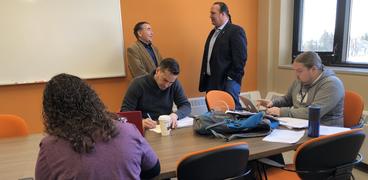“I want to work anywhere that benefits Native people.” “I want to support my tribe and protect its natural resources.” These were some of the statements made by the first graduating class of the Master of Tribal Resource & Environmental Stewardship (MTRES) program.
Shannon Kesner, who already holds the position of wetland specialist with the Fond du Lac Band, in Cloquet, Minn., says she is gaining a deeper understanding about the environment. The program makes clear that the “quality of our natural resources affect the health of our people, especially the quality of the water and air,” she says.
Tadd Johnson and Kekek Jason Stark (standing) with MTRES students.
Another student, Thomas Howes, who works with the Fond du Lac Band’s natural resources program, says the program is not only academic. “We study other approaches, and we can apply that wisdom. I appreciate seeing how the world turns in Indian Country.”
Kesner and Howes join two other students to make the first MTRES graduating class. The group is led by Professors Kekek Jason Stark, a Turtle Mountain Ojibwe, and Wendy F. Smythe, Alaska Native Haida. Kekek is an alumnus of Hamline University School of Law. He came to UMD with a long history commanding classrooms and courtrooms and serving tribal groups across the Midwest. Smythe is a geoscientist and oceanographer who received her Ph.D. from OHSU Center for Coastal Margin Observation and Prediction in Portland, Oregon.
The program concept for the MTRES program came when Wayne Dupuis ’87 at Fond du Lac approached Rick Smith, director of the UMD American Indian Learning Resource Center, and Tadd Johnson, now the senior director of American Indian Tribal Nations Relations for the University of Minnesota. During the following three years, they worked with UMD professors Howard Mooers, Jim Zorn, Rachel Breckinridge, and scores of others to develop MTRES. Smith, Johnson, and others from UMD met with natural resource managers in tribes across the Northland to get input. Johnson said, “MTRES is a program designed by Indian tribes for Indian tribes.”
Students participated in person and from remote locations in the MTRES program. The remote access feature of the program made it easy to switch to an all-online format when COVID-19 shelter-in-place protocol was instituted in March 2020.
Mark Pero, an MTRES class member from the Bad River Band, a tribe in Wisconsin, says, “Tobacco led me here.” He found out about the program and felt “an instant connection,” a connection he considers sacred, the same way tobacco is sacred to him.
Ever since Pero was a child, he has felt that “our people and the environment go hand in hand.” Pero enjoys the reading assignments, the class projects, and the discussions. “I know the program is leading me somewhere I need to be,” he says.
They all agree; MTRES is meaningful on a career level and a personal level as well.
Banner photo (above): The Grand Portage Tribal Council supported the use of an image of the tree called Manido Geezhigaynce (Little Cedar Spirit) as a symbol for the UMD MTRES Program. The council stated. "We feel that the dedication the program shows a stewardship of natural resources and respect for Anishinaabe culture." This photo of the Spirit Tree is by Travis Novitsky. It hangs in the UMD American Indian Studies classroom.
About the Master of Tribal Resource & Environmental Stewardship (MTRES)


